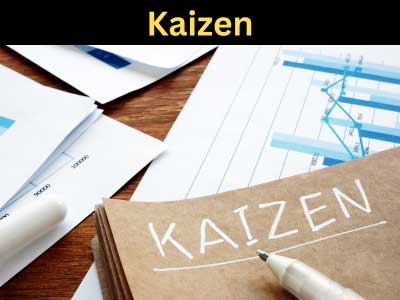Key Takeaway
The 4 P’s of Kaizen are Purpose, Process, People, and Performance. Purpose sets clear goals and objectives to guide improvements. Process refers to identifying and refining methods to achieve goals efficiently. People are central to Kaizen, as employee involvement is crucial for generating ideas and solutions. Finally, Performance measures progress and tracks outcomes to ensure improvements are sustained. These principles help create a structured, continuous improvement process that enhances efficiency, quality, and employee engagement, leading to long-term success.
Understanding the 4 Ps Framework
The 4 Ps framework in Kaizen offers a comprehensive approach to achieving continuous improvement. It focuses on four essential elements: Purpose, Process, People, and Problem-Solving. Each element plays a vital role in ensuring that improvements are sustained and that the entire organization is working toward common goals.
Purpose is about aligning improvement efforts with the company’s broader mission and goals.
Process focuses on refining and optimizing workflows to eliminate waste and enhance efficiency.
People are at the heart of Kaizen, as their involvement and ideas are critical to the success of any improvement initiative.
Problem-Solving ensures that challenges are addressed systematically, focusing on root causes rather than temporary fixes.
For engineers, mastering the 4 Ps is key to implementing Kaizen effectively. This framework ensures that improvements are not just about quick fixes but are rooted in sustainable, long-term strategies that align with the company’s vision.

Purpose in Kaizen and Lean Improvements
The first “P” in the Kaizen framework is Purpose, which refers to the clear alignment of improvement initiatives with the organization’s overall mission and goals. Purpose gives meaning to Kaizen activities by ensuring that every effort made to improve processes or reduce waste directly contributes to the larger objectives of the company.
When employees and engineers understand the purpose behind each initiative, they can focus their efforts on changes that have a meaningful impact. Purpose in Kaizen is not just about short-term gains but about driving continuous, long-term improvement that moves the organization closer to its strategic goals. For instance, if a company’s goal is to increase product quality, all Kaizen efforts will be geared toward eliminating defects and improving precision.
For new engineers, understanding Purpose in Kaizen means recognizing that every small improvement contributes to a bigger picture. By aligning their work with the company’s broader objectives, they ensure that their efforts are both relevant and impactful.
You May Like to Read
Process Optimization Through Kaizen
The second pillar of the Kaizen 4 Ps is Process. In Lean manufacturing, the primary focus is on process optimization, which involves continuously refining workflows to eliminate waste, reduce inefficiencies, and improve productivity. Processes in manufacturing often have hidden inefficiencies—extra steps, delays, or bottlenecks that slow down production. Kaizen focuses on identifying and removing these obstacles to create smoother, more efficient workflows.
One of the key techniques used in Kaizen for process improvement is Value Stream Mapping (VSM). VSM allows engineers to visualize the entire production process, identify areas of waste, and implement improvements that enhance the flow of work.
For new engineers, process optimization means constantly evaluating how things are done and looking for ways to improve them. It’s not just about fixing problems when they arise but proactively seeking out inefficiencies and working with teams to refine workflows continuously.
People Involvement in the Kaizen Strategy
People are central to the success of any Kaizen initiative. Kaizen emphasizes that employees at all levels of the organization should be actively involved in identifying problems, suggesting improvements, and implementing solutions. The idea is that the people closest to the process—whether they are workers on the production floor or engineers designing workflows—have the best insights into where improvements can be made.
In a Kaizen culture, employees are empowered to take ownership of their tasks and contribute to continuous improvement efforts. This sense of involvement leads to higher engagement, greater innovation, and more practical solutions. Kaizen events, often called Kaizen Blitzes, focus on short, intense problem-solving sessions where cross-functional teams come together to address specific challenges.
For engineers, understanding the role of people in Kaizen means working collaboratively with all team members, valuing their input, and helping create an environment where everyone feels empowered to contribute to improvements. People are not just passive participants but key drivers of change.
Problem-Solving Using the 4 Ps of Kaizen
The final element of the 4 Ps framework is Problem-Solving, which is critical to the success of Kaizen. Effective problem-solving in Kaizen focuses on finding the root cause of an issue rather than just treating the symptoms. This is achieved through structured problem-solving methods like the 5 Whys or A3 Thinking, which encourage a deep understanding of why a problem occurred and what can be done to prevent it from happening again.
In Kaizen, the approach to problem-solving is proactive, not reactive. Teams work together to anticipate issues before they arise, and when problems do occur, they are solved systematically. For instance, if a production line experiences frequent downtime, rather than just fixing the immediate issue, Kaizen problem-solving would focus on identifying the underlying causes and developing a long-term solution.
For engineers, learning to apply problem-solving techniques within the 4 Ps framework is essential. It involves not only technical skills but also collaboration, critical thinking, and a deep commitment to continuous improvement.
Conclusion
The 4 Ps of Kaizen—Purpose, Process, People, and Problem-Solving—are fundamental to driving continuous improvement and operational excellence in Lean manufacturing. By understanding and applying this framework, new engineers can contribute to building a culture of Kaizen that leads to lasting improvements in efficiency, quality, and productivity.
Purpose ensures that all efforts are aligned with the company’s goals, while Process optimization focuses on eliminating waste and enhancing workflows. People play a central role in driving improvements, and effective Problem-Solving ensures that challenges are addressed at their root. Together, the 4 Ps provide a comprehensive, structured approach to Kaizen that enhances its effectiveness and sustainability, helping organizations stay competitive and agile in today’s fast-paced manufacturing environments.
